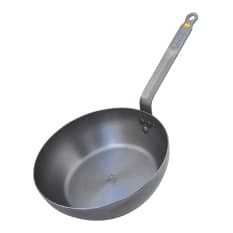Carbon steel cookware can last (almost) forever — here's what you need to know
You can quite literally turn up the heat in your kitchen with carbon steel cookware, given its superior heat control and even heat distribution, as well as its durability and versatility. Carbon steel heats up rapidly and can withstand high temperatures; and adapts easily to temperature adjustments, making it perfect for searing, browning and high-heat frying, even over an open flame. The sturdy cookware allows for better manoeuvrability, so you can sauté one-handedly (cue pro-level pan tossing action). It also builds its iconic non-stick patina with time — think of it as the fine wine of cookware: it only gets better with age. It’s also compatible with most stovetops including induction and works a treat for everything from stir-fry to steak to crêpes.
Here’s our guide on what it’s good for, what it isn’t good for, and how to take care of your trusty carbon steel cookware.

Why we love carbon steel cookware
- Carbon steel heats up rapidly and can withstand high temperatures
- It’s lighter in weight than its more robust cast iron counterpart — not quite as lightweight as stainless steel but not as heavy as cast iron tends to be
- It needs to be seasoned (by applying layers of oil and heating to form a protective layer), which gives it a lasting, naturally non-stick surface. The non-stick patina will improve the more you use it
- It’s ultra-durable and difficult to damage — which is why it’s a favourite in professional kitchens
- Carbon steel is inexpensive compared to other cookware material types
What is it good for?
- Carbon steel is ideal for high heat, fast cooking as well as dry cooking methods because it retains heat so well — from searing steaks and open-flame cooking, to crisping up chicken skin
- Using carbon steel pans on the grill can also help to get a smoky, charred flavour without losing marinades, oils, and fats through the grate
- It's also highly responsive to changes in temperature, which means you can go from searing to sautéing almost instantly
- Carbon steel is magnetic and can therefore usually be used on induction stovetops
- It gets full marks for durability and can be used with any type of utensils — bring on the metal spatulas! Just make sure not to scrape or scrub too hard because you can strip the seasoning you've so lovingly built over time

What isn't it good for?
- Carbon steel needs to be seasoned regularly and well looked after for it to develop longevity and non-stick properties, so it requires some TLC but the rewards you tenfold!
- Carbon steel pans shouldn't be heated too quickly (thermal shock can warp the cooking surface) — rather begin by heating your pan on low before slowly bringing it up to temperature
- Cooking highly acidic foods such as citrus, tomato paste, and vinegar in carbon steel risks stripping the pan’s seasoning and may add a metallic flavour to your dish
How to clean and season your cookware
- Carbon steel should only be hand-washed, it should never be put in the dishwasher
- It’s best not to use soap-based products to clean it, as this can strip the seasoning off your pan — try something like a fine cleaning mesh to help remove any food residue
- Carbon steel should never soak in water as it can rust when exposed to moisture for an extended period of time
- Allow your pan to cool down slowly rather than running it under cold water, this also helps protect the surface from warping
- Simply wipe with a paper towel while the pan is still warm to remove any remaining food residue
- Use a combination of a little coarse salt, hot water and a cloth to remove any really stubborn food
- Make sure it dries completely — you can heat it on the stovetop to dry up any moisture
- Re-season with a layer of neutral oil with a high smoke point (like sunflower oil) if needed after each use (especially when it's new and still building its non-stick layer) to maintain the patina on your pan
Hot (cleaning) tip!
- If rust rocks up at your carbon steel pan party uninvited — don’t panic! — you can scrub it off and re-season your pan by applying a thin layer of neutral oil and heating it to seal it in
- Examples of neutral oils include canola oil, sunflower oil, grapeseed oil, vegetable oil, and — you'll want to avoid using oils with a distinct taste, such as butter, olive oil, and peanut oil, which can impart flavours into the protective layer of your pan and have a lower smoke point




